BROOKLYN, NY - The New York Times reported on August 30th that the revised plan for the Brooklyn Queens Connector modern streetcar line proposed by New York City Mayor Bill Deblasio for the east side of the East River on Long Island's waterfront would mean a short, costlier route and not opening anytime soon, The route would be 11 miles instead of 14 miles, cost $2.7 billion instead of $2.5 billion and not begin construction until 2024. It would open in 2029, carrying 50,000 riders daily, the new study says. There is a $1.3 billion funding gap which the city hopes to cover with federal funds.
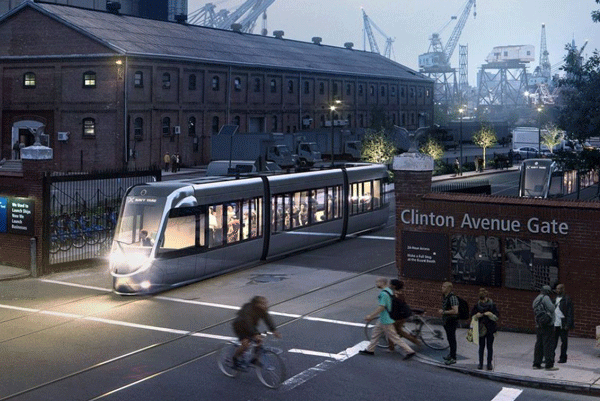 |
CINCINNATI, OH - The Cincinnati Bell Connector modern streetcar line marked its second anniversary on Sunday, September 9th, the Progressive Railroading website reported on September 4th. By August 19, the 3.6-mile car line had logged 1,200,000 rides since it opened. Service reliability and on-time performance improvements caused ridership to grow during weekday peak periods and on weekends and for special events, a regional transit authority spokesman said. Two hour passes cost $1.00 and all-day passes are $2.00.
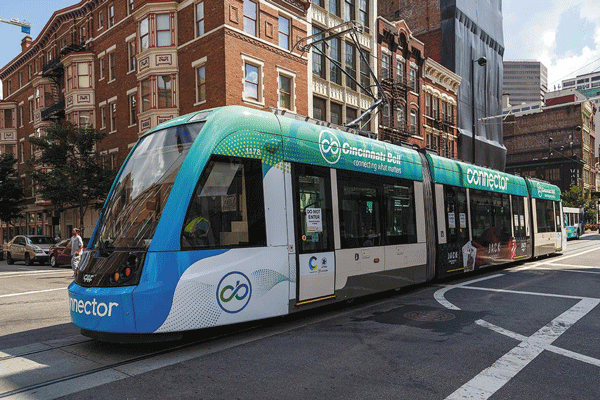 Cincinnati Connector CAF-built #1178 in 2017! Cincinnati Connector CAF-built #1178 in 2017! |
DENVER, CO - Denver Regional Transportation District [RTD] was closed four downtown light rail lines for 10 days in September for track replacement, Colorado Public Radio reported. The closure from September 14 to 24 enabled replacement of 24-year-old LRT track, serving routes D, F, H and L which terminate downtown at 18th & California and 16th & Stout. The project was funded by a $2.5 million Colorado Department of Transportation grant. RTD outreach manager Lisa Trujillo said the project is part of the agency's state of good repair program. Buses replaced LRVs during the closure
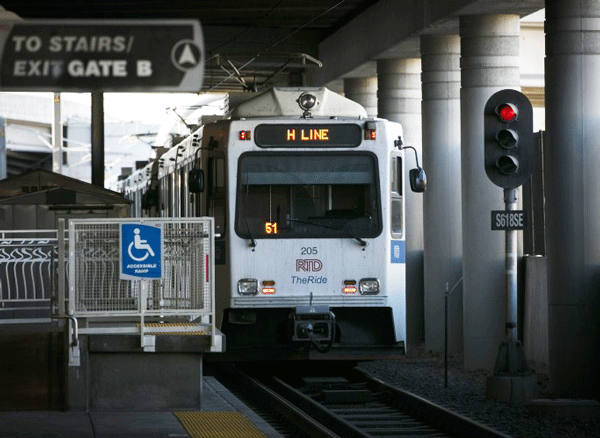 |
EL PASO, TX - El Paso television station KFOX reported that Brookville Equipment of Pennsylvania was scheduled to deliver the Texas city's fourth rehabilitated PCC streamline streetcar Tuesday, September 25. It is in same green livery as the third car delivered. Testing was to start September 26th. Six original El Paso City Lines PCCs bought secondhand from San Diego are due to serve the new line, built entirely with Texas state funds. So far cars 1504, 1506, 1512 and 1514 have been deleivered. These four cars originally were San Diego Electric Railway cars 509, 512, 519 and 523, respectively until 1948!
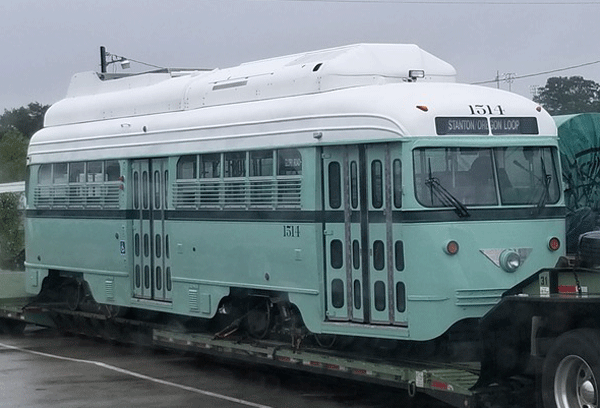 Car 1514 on 9/23/18 enroute to ElPaso in Cisco, Texas, about 400 miles east of El Paso! Car 1514 on 9/23/18 enroute to ElPaso in Cisco, Texas, about 400 miles east of El Paso!
|
The El Paso Incl. website posted a local media story about the arrival of the fourth Brookville-rehabilitated PCC streetcar at the west Texas city. The article noted that the 4.9-mile car line will have five substations to deliver 650 volts DC current to the pantographs. The ride from downtown to the University of Texas-El Paso campus will take 40 minutes. Six PCCs are being rehabbed and modernized. The final two will be in National City Lines "fruit salad" yellow, white and green livery, which was used also in Los Angeles.
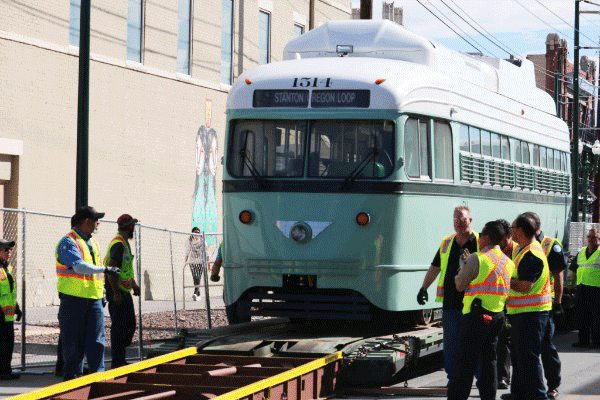 Car 1514 being unloaded during the morning, 9/24/18! Car 1514 being unloaded during the morning, 9/24/18! |
ISRAEL - The Israel National News website reported September 21st that a district court decided to permit light rail construction work at one station site on the Sabbath, thereby speeding work. The stop work order had affected Bnei Brak station but was deemed dangerous by the court. A lawyer for the mass transit system now under construction said by halting work, the ground could sink endangering homes and businesses. Tel Aviv, a seacoast city, has the largest metropolitan area population in Israel.
KANSAS CITY, MO - Kansas City Streetcar Authority (KCSA) is requesting $151 million in federal funding for its streetcar extension project, Kansas City Business Journal reported on September 11th. The revised overall cost is $316 million with the rest coming from local sources. Six additional streetcars will be needed for the 3.6-mile extension from Union Station south to the State University campus due to open in 2023.
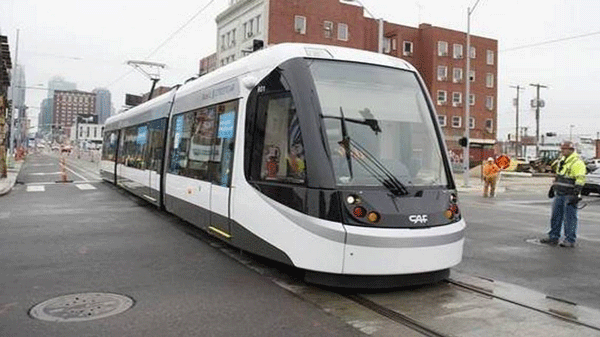 Kansas City streetcar supporters are gearing up for a streetcar expansion election! Kansas City streetcar supporters are gearing up for a streetcar expansion election! |
After less than two and one-half years, the Kansas City modern streetcar line using C.A.F.-built rolling stock logged five million riders by the weekend of September 16, as the KSHB television reported on September 18th. Donna Mandelbaum, spokeswoman for the Streetcar Authority, said the project is so successful that two more streetcars will be purchased. That will provide a fleet of six streetcars. One problem: scooters are using the track areas and officials worry their tires could get caught in the rail flangeways. A new campaign is being launched in September named "Respect the Rails". The new streetcars will be delivered in mid-2019.
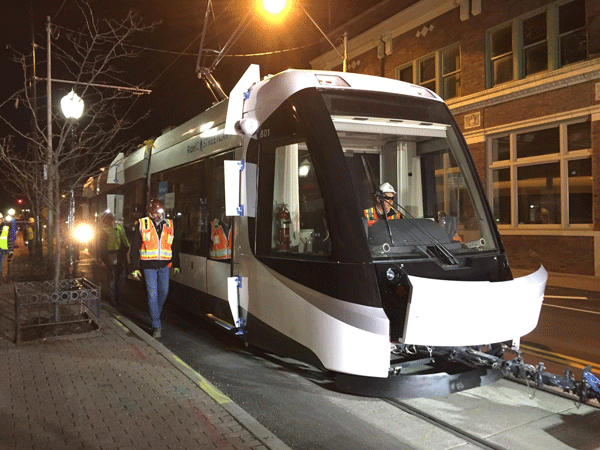 KC 801, the very first of the new cars, being towed on its very first trip along the line just after delivery from Elmira, New York in November 2015! KC 801, the very first of the new cars, being towed on its very first trip along the line just after delivery from Elmira, New York in November 2015! |
Kansas City Fox 4 News reported that the west Missouri city's Streetcar Authority is seeking musicians to ride the cars during the Thanksgiving to Christmas holiday season and serenade riders. Applications are due October 19th. Musicians will be paid $300 for two hours and may play holiday tunes or other forms of music including jazz or folk.
MILWAUKEE, WI - Milwaukee television station WTMJ reported on August 31st that three motorcyclists have crashed on the tracks of the Wisconsin city's new starter streetcar line -- all in approximately the same spot. Signage says bikers should cross tracks at a 90 degree angle. But bikers say that's not possible and tires got wedged in tracks. A law firm representing the three cyclists says the most each could get from the city is $50,000, not covering medical costs in some cases.
The fifth and final streetcar for this line arrived on Friday, September 7th, WISN-TV said in a same day report. Crews spent an hour unloading the Brookville Equipment Corporation (BEC) Liberty model car at the car house. It journeyed to the Wisconsin city on a flatbed truck trailer from western Pennsylvania.
The $128 million car line restores urban rail transit abandoned in 1958. Rides will be free the first year thanks to sponsorship by a tribal casino. Mayor Tom Barrett says skeptics should ride on the "Hop" as the line is branded for marketing. Barrett says the new vehicles are a far cry from 1940s trolleys. BEC now has cars operating, under construction or ordered by Dallas-Oak Cliff, Detroit, Oklahoma City and Tempe, Arizona, in addition to Milwaukee.
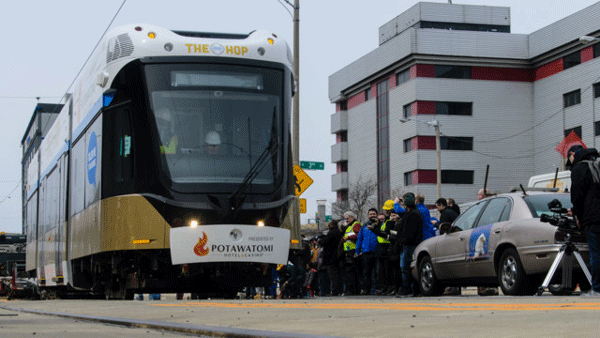 |
The Milwaukee modern streetcar line, 2.5 miles and $128 million in the downtown area, was hosted a bicycle safety event Thursday, September 20th, as reported by the Journal Sentinel. The major thrust is that cyclists should cross rails at a 90 degree angle to avoid getting tires caught in rail flangeways. The streetcar system also will show how to take bicycles onto the rail vehicles and where to store them on board,. The "Hop" streetcar is due to open to passenger service in November 2018 with a wire-free extension to the lakefront high-rise complex in 2019.
Note: Many decades ago, we had a lot more streetcars with tracks in the streets and a lot more bicycles and we managed to avoid major issues. What happened?
The public debut of the Milwaukee streetcar line will take place November 2nd, the Journal Sentinel newspaper website reported September 28th. Mayor Tom Barrett said the car line will help stimulate the economy. There will be a ceremony at noon and music and other entertainment will be furnished to those waiting for inaugural rides.
MINNEAPOLIS, MN - Twin Cities Metro Transit closed part of the Green Line light rail route at St. Paul and substituted buses from 8:45 p.m. Friday, September 21st until Saturday, September 22 at 10 a.m. The reason: scheduled maintenance work along the line from St. Paul Union Station to the state capitol station. Replacement buses were to stop opposite light rail stations. In all, four LRT stops were affected, KTSP television reported.
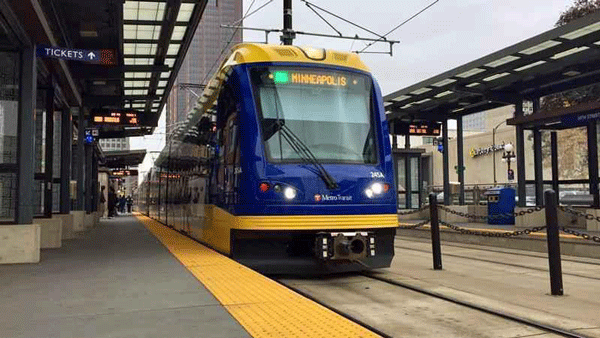 |
NEWCASTLE, NEW SOUTH WALES. AUSTRALIA - The Newcastle Herald reported on September 10th that the first light rail vehicle (tramcar) arrived at the city along Australia's Pacific Ocean coastline by cargo ship from Spain. The delivery took place Saturday, September 8th and the LRV was off loaded onto the dock. In the coming days, it will be moved by highway truck to the car house (stabling facility) at Wickham. Initially there will be nighttime testing but later a full schedule without passengers will be operated in the daytime to test the timetable. The LRT route from downtown to a suburban passenger rail transfer is currently scheduled to open in 2019.
Newcastle is a harbor city in the Australian state of New South Wales.
NEW ORLEANS, LA - The New Orleans Times-Picayune website reported on September 26th that the Canal Street car line will be extended to Riverfront to provide all-night service. This is intended to provide a transportation option to hotel and restaurant workers who must show up for their shifts overnight. In addition, the 16-Claiborne bus wll provide 24 hour service starting at the end of September.
Car 461, built for the Riverefront line (no Brill 76E trucks) shown in its latest paiunt scheme imn May 2010. the car has been in three different schemes over the years. The first, shown below left,. was similar to what it is today except that it bore the words RIVERFRONT on the dasher. it is shown on a deadhead trip from Carrollton on the Saint Charles Line. Note the NOT IN SERVICE sign hanging under the front window as passengers were not allowed to ride on these trips. The car number is now on the dashser sbove the headlight.
Then there was the experimental blue livery shown above right, worn briefly in 2004-2006.
ORANGE COUNTY, CA - The Orange County Breeze on its website reports that Orange County Transportation Authority (OCTA) is seeking public comment on the exterior design of Siemens streetcars that will serve the Santa Ana to Garden Grove car line. The designs are listed by the agency's board -- all in blue, white and orange, the county's colors. The 4.1 mile line will have eight streetcars, the Breeze reported on September 7th. The Siemens S70 streetcars will be similar to those purchased by Salt Lake City and Atlanta. Preliminary construction of the Santa Ana-Garden Grove line will begin later this year. Operation could begin in 2021. Each streetcar will carry the words, OC Streetcar -- to brand the new service.
A map of the proposed line:
The "voice of OC" reported that the cost of building the Santa Ana to Garden Grove modern streetcar line has risen to $407 million, up from initial estimates of less than $300 million. The reasons are inflation in labor, steel and other costs. Under the revised estimate, the federal government would pick up 52 percent of the costs. the OC website reported September 20th. It also said the Harbor Boulevard proposed for northern Orange County was nixed by two of the four cities involved. Anaheim and Fullerton objected.
The Progressive Railroading website reported in late September that the Orange County Transportation Authority has awarded a $220.5 million contract to Walsh Contracting to build the Santa Ana to Garden Grove modern streetcar line. The service is due to begin operation in 2021. Last March, the authority awarded a $51 million contract to Siemens to supply eight S70 model streetcars similar to those in use in Atlanta and Salt Lake City.
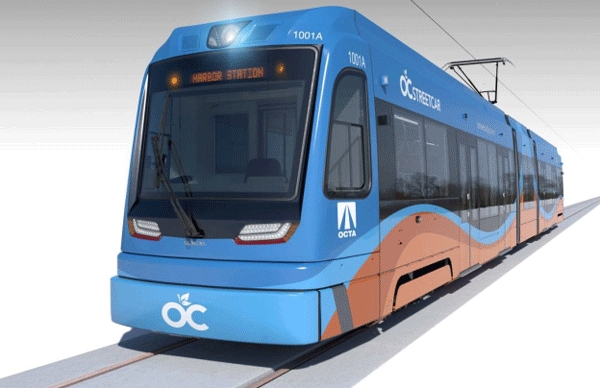 |
PHILADELPHIA, PA - Philadelphia television station WXTF, Fox 29 News, reported that Market Frankford Subway Elevated (MFSE) service through Center City was suspended Wednesday, September 19th because of debris that fell onto the tracks at the Eighth Street station. The cessation of service allowed engineers to inspect the tunnel at that location where MFSE meets the PATCO line to Lindenwold, N.J. It was not immediately clear why debris fell from the ceiling. Shuttle buses were employed from 15th Street to Spring Garden stations. When rail service on MFL resumed, it was restricted to the eastbound track only, causing delays. Riders had the option of riding Regional Rail through the Center City Commuter Tunnel.
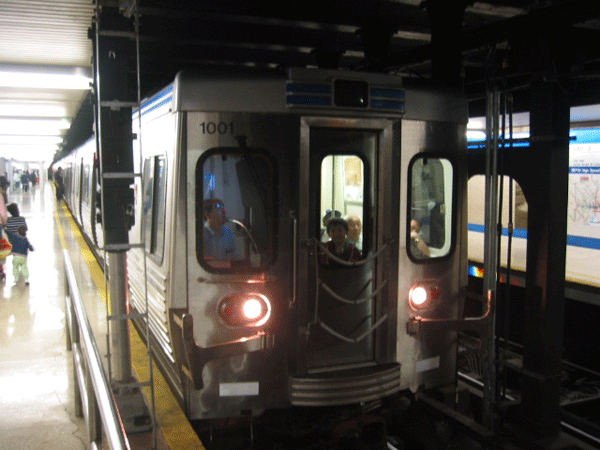 |
PHOENIX, AZ - Public radio station KJZZ of Phoenix reported that Valley Metro transit wants to change South Central Avenue to only two auto traffic lanes to make room for median strip light rail. In a website post September 21st, KJZZ said Phoenix City Council was scheduled to be asked Wednesday, September 26th, to approve the change from four traffic lanes to only two. It's controversial because small businesses and residents along the corridor fear the change will mean lost retail trade and disruption. The LRT route would extend south from downtown to Baseline Road through a corridor with heavy minority group and low-income population. But Valley Metro officials say the two-lane option needs approval soon so a federal grant request can be submitted by a November deadline. Federal and local sources would pay for the project.
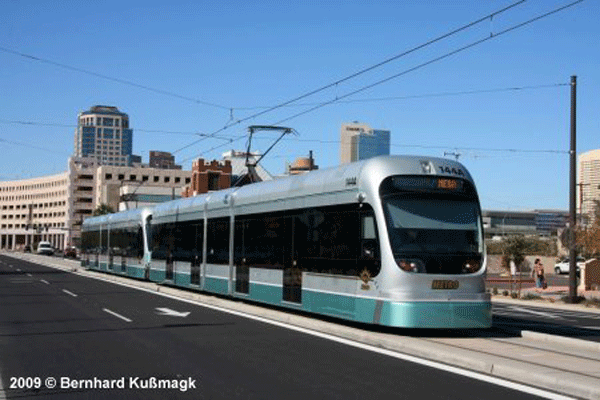 |
According to a report by Progressive Railroading, the Phoenix City Council on September 26th voted to build Valley Metro's two-lane South Central light-rail extension as planned.
The city approved the 5.5-mile project in spite of resistance from a grassroots group known as "4 Lanes or No Train," which formed earlier this year to stop the project, The Arizona Republic reported.
The group was concerned that the project would cause traffic bottlenecks and harm local businesses, the paper reported.
In a prepared statement, Phoenix Mayor Thelda Williams said the South Central project would connect neighborhoods to opportunity and spur economic development in the area.
Wednesday's vote confirms the city's commitment to the $1 billion project and provides the reassurance the Federal Transit Administration (FTA) requires to release nearly $600 million in project funding, according to a press release issued by local advocacy group Build South Central Coalition.
To receive the federal funds, the project must remain on its existing timeline, which includes starting the engineering phase by November, the Phoenix New Times reported. The city was considering a four-lane configuration for the project, but that likely would have required a new environmental assessment that would delay the project.
Valley Metro Chief Executive Officer Scott Smith told council members that any delays could remove the project from the federal grant queue, according to the newspaper.
And if Valley Metro were to reapply for an FTA grant, the project could be delayed by two to three years, Build South Central Coalition officials said. Reapplying for the grant also could add $35 million to $50 million in design and pre-construction fees, they added.
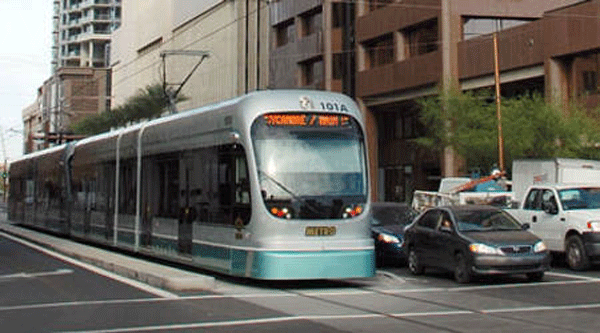 |
PORTLAND, OR - The Oregon Live website reported that 38-year-old man, who was angry at Portland TriMet, the city's light rail and bus operator, punched the front windshield of a Portland Streetcar, damaging it. Now, the man must pay $3,900.00 to repair the damage and get mental health counseling.
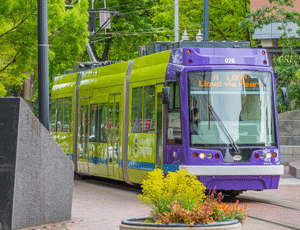 Car 026, built by United Streetcar in 2014, in service. Car 026, built by United Streetcar in 2014, in service.
|
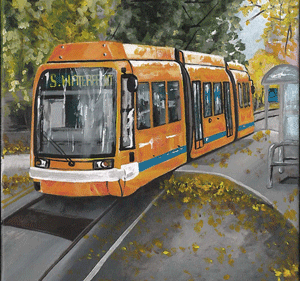 Image of Portland streetcar painted Image of Portland streetcar painted
by local artist in 2016. |
SEATTLE, WA - Seattle's Sound Transit's board on September 27th selected an elevated light-rail alignment for its Link light-rail extension in downtown Redmond, Washington. The move brings the Redmond Link extension one step closer to the start of construction in 2019, with service slated to start in 2024, agency officials said in a press release.
The 3.4-mile alignment will run along the State Route 520 corridor from the future Redmond Technology Center Station to an at-grade southeast Redmond station near the intersection of state roads 520 and 202. From there, the extension will turn west under State Route 520 along a former BNSF Railway Co. corridor, where it will be elevated to cross Bear Creek and terminate at an elevated station at 166th Avenue Northeast and the Redmond Central Connector Trail. The chosen alignment incorporates refinements identified through close work with the city of Redmond, the King County Department of Natural Resources and Parks, King County Metro Transit and the Washington State Department of Transportation. Those features are aimed at improving service reliability and safety by separating trains from vehicle and pedestrian traffic, according to Sound Transit.
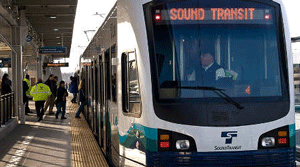 |
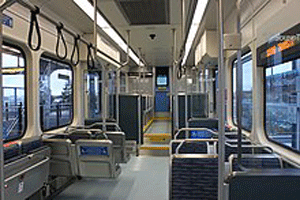 |
"Strong partnerships between the city of Redmond, Sound Transit and our other regional partners have enabled us to move forward with light rail in Redmond that will be a win for transit riders, drivers and pedestrians alike," said Sound Transit Board Vice Chair and Redmond Mayor John Marchione. "We look forward to breaking ground on this long-anticipated project next year." In 2011, Sound Transit's board adopted a previously approved route to downtown Redmond as part of the larger East Link project. However, the downtown extension didn't receive funding until regional voters approved the Sound Transit 3 ballot measure.
Sounder started with the 62 vehicles fromn KinkiSharyo purchased in 2003, 2005 and 2009 and has ordered up to 152 vehicles from Siemens due to the extensions underway. thes ystems uses a line voltage of 1,500V to reduce substation spacing to one mile.
TORONTO, ONTARIO, CA - The King Street streetcar line, one of the busiest in Toronto, was diverted to Queen Street from September 6th to 10th to accommodate the Toronto International Film Festival Street Fair. It was to draw celebrities but Toronto Transit Commission commuters were less (and rightfully so...) than pleased (...and rightfully so in the writer's opinion...) with the diversion. the "toronto storeys" website reported September 4th. The King streetcar gives rides to roughly 80,000 people daily.
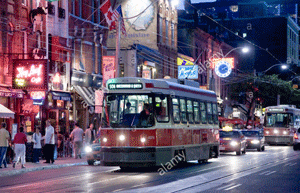 TTC CLRV 4074 on King in the Theatre District. TTC CLRV 4074 on King in the Theatre District. |
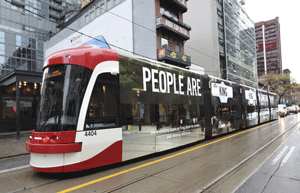 TTC Five-Unit Bombardier Tram on King. TTC Five-Unit Bombardier Tram on King.
|
|
A study by Ryerson University shows that the King Street pilot project to speed streetcar travel in downtown Toronto from Bathurst to Jarvis is saving streetcar commuters $11.5 million CAD (or USD $8.9 million), the Toronto Star reported September 21st. The change adopted in November 2017 has increased ridership from 72,000 to 80,000 through last June. The study authors recommend the change be made permanent. Autos only can drive one block and then must turn right.
TUCSON, AZ - For the first time in four years, the Tucson Sun Link streetcar was forced to close its entire line during the summer monsoon season to clear storm debris from the tracks, the Tucson News Now website of TV stations KOLD-KMSB reported. The monsoon ended September 20 with all-day continual rain after beginning in early July. The 3.9-mile line was closed during the first storm in early July to clear dirt and rocks from the rail flangeway. The closure lasted four hours. Meanwhile, the Arizona Daily Star reported ridership hit the four million mark since the car line opened in July 2014.
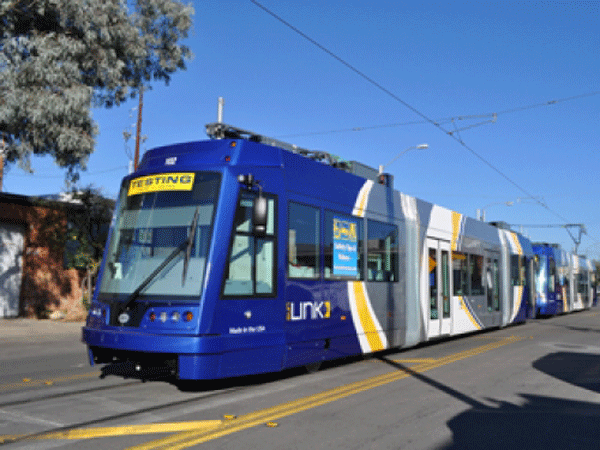 |
The Tucson Sun Link modern streetcar line recorded its 4,000,000th rider on September 20th as reported by television station KVOA on the same day. The 3.9 mile car line in Arizona's second largest city was opened in July 2014. It uses eight United Streetcar LLC units built in Oregon. The ridership milestone was marked by a gift bag for the young male rider and live music onboard by a band. The University of Arizona provides many riders to the line.
VANCOUVER, BRITISH COLUMBIA, CANADA -The "urban hive" website reported that the planned Surrey-Newton-Guildford light rail line in the suburbs east of Vancouver, British Columbia, will not improve transit mobility compared with buses. The project has the blessing of the Surrey city government and will receive federal and provincial funding. But Randal O'Toole, a Cato Institute fellow who opposes any LRT projects anywhere, says LRT for Surrey is a waste of money.
YORK, PA - Streetcars in this Pennsylvania town didn't last until World War II but the city and suburban system shrank local travel with speedy rides, the York Daily Record reported last month. A Brill-built copyright infringement "rubber stamp" curved side car survives and has been restored to operation at Rockhill Trolley Museum, Rockhill Furnace (Orbisonia) in central Pennsylvania: